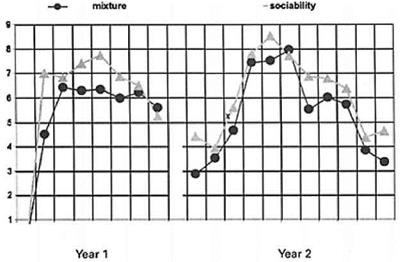The use of seed mixtures to create flowering wildflower meadows has always relied upon complete randomness to achieve its aims. The use of broadcast mixed seed to cover an area with vegetation not only produces a truly spontaneous effect but it also enables a very close ‘fit’ of that vegetation to site conditions: different species will respond to variations across a site in such factors as fertility and moisture in different ways and will, therefore, ‘distribute’ themselves accordingly.
The make-up of a seed mix can be based upon exactly the same factors as those outlined in the section above on randomly planted perennial mixtures. The use of seeding as a technique has been very well-developed in relation to the use of native species in meadow mixtures, but its application has been very limited outside of this field. There is, however, no reason why the use of seeding should be confined to native wildflowers. The majority of cultivated plants in temperate landscapes, for example, originate from grassland habitats, and exactly the same techniques can be used for producing meadowlike mixtures of non-natives as for natives. James Hitchmough’s chapter on herbaceous vegetation in this book discusses the use of seed mixes for ornamental plantings in depth (Chapter 6).
Seeding can be combined with other types of establishment methods. For example, a combination of seeding and planting of perennials (if a framework of perennials is planted first at relatively low density and then a seed mix over-sown to fill the gaps between the plants) can give the advantage of a definite structure and provide guaranteed results from the planted species in the initial stages, combined with the truly naturalistic effect of the seed mix.
|
|
9.10 A visual comparison of the same mixture of species in the same proportions planted according to one of four different methods: random mixture, according to the sociability of each species, using drifts and using blocks. Visual scores are on a scale of 1 (no visual appeal) to 9 (highest visual appeal)
Conclusions
There are merits to all the approaches to specifying and designing plantings described in this chapter. A major conclusion, however, is that the standard method of depicting a detailed naturalistic planting plan (the Garden Habitat or Plant Sociability based method) has relatively little application on a wider scale outside of the private garden, the botanical institution or the well-resourced scheme where the designer can also be involved in plant placement and layout. This is because the sheer complexity of the plantings, where, in many cases, each plant has its own location, makes not only for a very timeconsuming (and, therefore, expensive) process but also one which requires a good deal of skill and feeling for the naturalistic distribution of plants.
We propose that there is merit in relying much more heavily on a randomised, mixed approach to planting (whether from seed or through planting, or both), given that the evidence appears to support the idea that a completely randomised planting (if the balance of species and cultivars is correct) appears to lose little in aesthetic terms. Having said this, there is a role for varying degrees of plant placement within random plantings. It may be, for example, that the more structural species (the dominant or ‘theme’ plants of the Plant Sociability school) are shown on a plan scattered in their actual positions. In this way, a framework is developed within which all the other species are introduced as mixtures. It may be that, as with naturalistic woodland planting, each species is planted in groups of constant or varying sizes, rather than as individuals. And, of course, a variety of different mixes can be used within any given area. In this respect, a mixed planting plan may be quite similar to ‘drift planting’, only instead of each drift or group being composed of a single species, in this instance they may contain a mixture. Where a variety of mixes are being used, there may be some common components to the majority of the mixes to ensure some form of unity or coherence across a scheme, or they may be quite different from each other. And some drifts or blocks may indeed be monocultural, the effect might then be similar to the plot shown in figure 9.5.
What must be stressed when advocating the greater use of mixtures is the avoidance of a formulaic procedure, whereby the same mixtures are specified universally across a region or country. The specification of mixes (whether with plants or seed, or both) can be as creative as the formulation of traditional planting plans—it simply requires a different set of skills from the purely horticulturalbased




